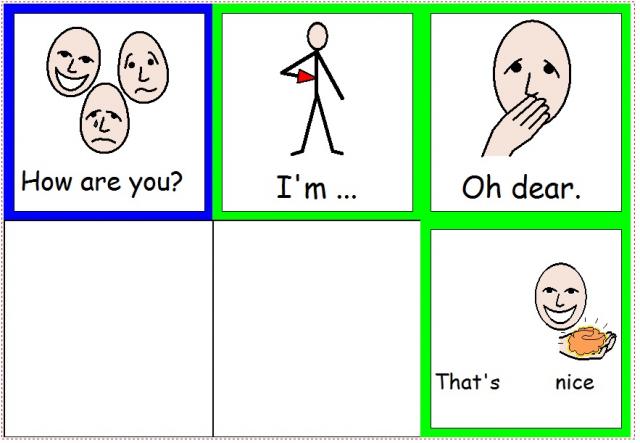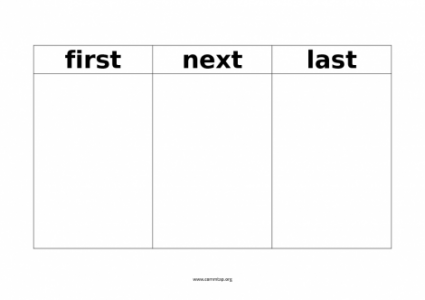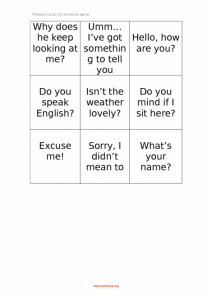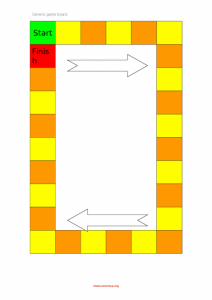Search
User login
Topic “Adult”
Adults - for those over 16 years
How are you conversation prompt pictures
Picture:

Picture description:
Prompt pictures for three turns in a conversation beginning "How are you?"
Simple topic maintenance
| Activity/strategy name and materials required | How to do the activity | Key principles for doing the activity and comments |
|---|---|---|
| My interests |
| |
| Topic introduction
| ||
| Talk about it
| Optional:
| |
| Likes and dislikes Something to record the students responses on (e.g. paper/pen) which can later be used as a prompt; Soft ball or beanbag. | To make it harder, you can go around again asking for favourite drinks - so that everyone now has to remember a food and a drink for each student when they pass the ball (e.g "Tim - (you like) carrot cake and tea"). You could use favourite games, favourite places to go, etc. instead. | |
| What have you done today? Way of recording students responses - e.g. paper/pen, whiteboard/marker; Soft ball or beanbag. |
Describe a practical activity having three or more steps
| Activity/strategy name and materials required | How to do the activity | Key principles for doing the activity and comments |
|---|---|---|
| Breakfast Breakfast food and implements, rough sketches or photos of each stage in the sequence to use as prompts. Ideas for sequences: Toast
Note: you can simplify the sequence - e.g. bread - toaster - spread butter. Or you could make it more complex. Make a cup of tea
As with the toast, you can simplify this or make it more complicated! |
| This activity incorporates some automatic feedback - if the student gets it wrong, then it will probably not work and they will need to correct themself. |
think and talk about events in the past and future
| Activity/strategy name and materials required | How to do the activity | Key principles for doing the activity and comments |
|---|---|---|
| Which day? Sheet of paper with 3 boxes drawn on them for yesterday, today and tomorrow. A counter. Optional: sets of symbol cards or pictures showing a variety of activities - including activities the student may have done. You can create symbols cards using the Commtap Symboliser for PowerPoint. | 1. Talk about each day, one at a time. Get the student to draw or write things they have done or will do in each box. Use the picture symbols if the student is having difficulty coming up with things. 2. When you have finished, explain that there is going to be a quiz. Describe an activity and the student must say if they did it yesterday, did it today or will do it tomorrow. 3. Have them step the counter over onto the right day. | This works best when there are key things which are different about each day! |
| The Story of Fred Set of three pictures - one showing a picture of a child, one showing a picture (preferably of the same person!) at a similar age to the student and one a picture of an older person. These could be photographs or drawings. Choose three ages which are appropriate/relevant for the student.
Large 'thought clouds ' on A3 or A4 paper: Sticky tape Pens Picture symbol prompts if required. You can create symbol prompts using the Commtap Symboliser for PowerPoint. | ||
| Calendar Calendar Pens | This is an ongoing activity. You could take photos of the key events, and put them on the calendar. | |
| Daily Schedule/Picture Schedule Any activity or set of activities where the student might use a schedule or have a visual timetable. You can create a visual timetable/schedule using the Commtap Symboliser for PowerPoint. |
Sequence three pictures related to hygiene
| Activity/strategy name and materials required | How to do the activity | Key principles for doing the activity and comments |
|---|---|---|
| Self Care Activities Camera to make the picture sequences (or alternatively you can draw them or use a commercial resource). Resources as appropriate to carry out a simple sequence Examples of sequences: Clean teeth: get toothpaste, open lid, get brush, squeeze toothpaste onto brush, put lid back onto toothpaste, brush teeth, spit out, put brush under water, repeat, clean brush, put brush away. Wash hands: turn on tap, rinse hands, put soap on hands, scrub hands, rinse under water, turn tap off, dry with towel. Brush hair: get brush, brush hair, put brush away. Deodorant: get deodorant, take off lid, spray at appropriate area, put lid back on, put away. | 1. Carry out the sequence without the pictures; 2. Do it again, showing the relevant picture for each part of the activity as you do it; 3. Get the student to do the sequence, showing them a picture for each part of the sequence as they do it; 4. Get them to show you what to do by giving you a picture for each part of the sequence. Try to do exactly as the picture you are given indicates, for example if they give you a picture of scrubbing your hands before the tap is turned on/before you have the soap, try to do this - but appear confused when this doesn't work. | At this level students may often be able to learn particular sequences of pictures without understanding that they relate to a sequence of actions, these activities are designed to address this issue. Seeing how the sequence goes wrong if the wrong picture is chosen (in step 4) will encourage the student to work out which should have been the right picture without you needing to give any further feedback. |
Share information about self with others
| Activity/strategy name and materials required | How to do the activity | Key principles for doing the activity and comments |
|---|---|---|
| Likes and dislikes Optional - something to record the students responses on (e.g. paper/pen) which can later be used as a prompt; Soft ball or beanbag. |
| To make it harder, you can go around again asking for favourite drinks - so that everyone now has to remember a food and a drink for each student when they pass the ball (e.g "Tim - you like carrot cake and tea"). You could use favourite games, favourite places to go, etc. instead. |
Talk about things in the recent past
| Activity/strategy name and materials required | How to do the activity | Key principles for doing the activity and comments |
|---|---|---|
| What have you done today? Optional - way of recording students responses - e.g. paper/pen, whiteboard/marker |
| Variations
|
| What have you done today - with a ball Optional - way of recording students responses - e.g. paper/pen, whiteboard/marker Soft ball or beanbag |
To make eye contact
| Activity/strategy name and materials required | How to do the activity | Key principles for doing the activity and comments |
|---|---|---|
| Gain visual attention Use something that the person may be visually attracted by, for example:
|
| Remember that although the room needs to have little visual distraction the light needs to be sufficient to allow clear eye contact to be made e.g. a low light sensory room may not be so good for this activity. |
First next last; first last templates
Template to use for first/next/last or first/last sequencing - with space for pictures. Example activities: sequences three pictures with first next and last.
Created 18 October 2012; updated 19 July 2015.
Phrases cards for emotions game
Created 18 October 2012; updated 30 April 2022.
Generic game track
A coloured track which, along with dice and counters for example, could be used to make a variety of activities into a game - for example, shake the dice, move the counter, and if you land on an orange square, pick a card and describe what is on it.
Created 18 October 2012; updated 19 July 2015.
Sources of Information, Support and Additional Resources
Created 10 October 2012; updated 2 August 2025.
Sources of Information, Support and Additional Resources
This is a list of some sources of information, support and resources in the UK. You can edit this page, or you could create another page for organisations in your country.
Information and Support
Use two key word instructions in everyday activities
| Activity/strategy name and materials required | How to do the activity | Key principles for doing the activity and comments |
|---|---|---|
| Making a cup of tea - telling you what to do Kitchen with everything appropriate for making a cup of tea. You don't need to have them out and ready though - finding the stuff can be part of the activity. | 1. Sit in the kitchen at an empty table and say you want to make a cup of tea - but you don't know what to do (or have forgotten what to do); 2. See if the person suggests getting something - e.g. teabag or cup. If the person suggests something, e.g. teabag, ask where you can find it. See if they can tell you - e.g. "cupboard" - but if not, give then some suggestions - e.g. "in the cupboard or in the fridge?" - have a look in the fridge if they suggest that. If the person doesn't suggest anything, give a funny choice, e.g. shall I get a cup or a paint brush - if they suggest "paint brush", get one and then look really confused when you have it - see if they can correct you, or if there is not paint brush to find, look equally confused. Get a cup even if they don't prompt you to get one (as if you've suddenly remembered!) 3. As you go along, try to get the person to extend the language - but don't try to get them to repeat, also try to avoid asking leading questions (for example avoid asking "shall I stir the tea now?"). For example if you have a tea bag and a cup, and they say "cup", indicating that you put something in the cup, put something else in the cup - e.g. a pen. If they then say teabag, do something with the teabag - but don't put it in the cup. At this point they may try to put the two words together, e.g. "teabag...cup". If not, you can give them a choice. Try the following: "teabag in the cup or pen in the cup" (you might get a response of "teabag" in which case put it somewhere - not in the cup); or "teabag in the cup or pen in the bag" or "pen in the bag or teabag in the cup" (easiest because the target phrase is last). | If the person is not familiar with making a cup of tea already, you should spend some time doing this - talking them through what you are doing as you make the tea. The key principle here is to give the minimum amount of prompting. You will need to adjust the level of prompting so that the person is a little bit challenged by the task - but not so much that there are long pauses (what constitutes a long pause will vary from person to person). As far as possible, you are trying to literally do what the person says - so if they say something that's potentially ambiguous, choose a more amusing interpretation of what they have said. The idea is that this activity should be really fun, and also prompt the person to try and add more information and be more accurate. |
| Everyday activities Whatever is required for the activity. Activities could include:
|
Text mangle tool
See the "comments" link associated with this page for more information about this tool.
What this tool is for
The purpose of this tool is to be able to get a flavour of:
- What an early reader might get from text;
- What can be gained from text where only a selected number of high frequency words are used;
- How a strategy of signing could assist comprehension;
- Or...to create your own Jaberwocky poem!
See the comments page for more information on this tool.
Support Commtap to keep it online
Thank you for visiting Commtap.
Please read this message as it is extremely important.
- Visitor donations mean we can continue to host over 1,000 free activities to support speech, language, and communication development.
- Visitor donations mean we can continue to provide free resources to address a wide range of communication needs, including limited speech or language, interaction challenges, and needs associated with conditions such as developmental language disorder, autism, and cerebral palsy.
- Visitor donations mean we can continue to provide resources to support the work of speech and language therapists, teachers, teaching assistants, parents, and carers.
- Visitor donations mean we can continue to provide the free key word sign dictionary (bks.org.uk) which has over 2,000 Makaton and Signalong signs.
We know that not everyone is able to afford to pay to access these resources, however, if you can, please make a donation to keep the site going.
Thank you
Google ads on this page are provided by Google Adsense - and their presence does not imply any endorsement by Commtap. Report a problem with an ad on this page. Log in (for free) to avoid seeing Google ads.





